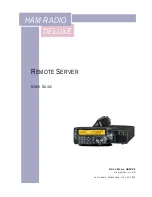
Using SNMP with the Access Server
222
Model LRA2900A RAS Administrators’ Reference Guide
18 • SNMP
Get Next Requests (snmpOutGetNexts)
The total number of SNMP Get-Next PDUs that have been generated by the SNMP protocol entity.
Set Requests (snmpOutSetRequests)
The total number of SNMP Set-Request PDUs that have been generated by the SNMP protocol entity.
Get Responses (snmpOutGetResponses)
The total number of SNMP Get-Response PDUs that have been generated by the SNMP protocol entity.
Traps (snmpOutTraps)
The total number of SNMP Trap PDUs that have been generated by the SNMP protocol entity.
Authentication Failure Traps (snmpEnableAuthenTraps)
Indicates whether the SNMP agent process is permitted to generate authentication-failure traps. The value of
this object overrides any configuration information; as such, it provides a means whereby all authentication-
failure traps may be disabled.
•
enable (1)
•
disable (2)
Using SNMP with the Access Server
SNMP is used to configure and monitor the access server. There are numerous third-party software applica-
tions available that are capable of using SNMP to control the access server.
To interact with the access server, these network management applications need:
•
A community string which determines their level of access to the access server
•
An object identifier which identifies the specific parameter the application wants to view or modify
SNMP has two levels of access:
•
Read-only, for which the community string is the user password
•
Read/write, for which the community string is the superuser password
Object identifiers (OIDs) comprise a series of integers separated by dots that identify a specific parameter (for
example, 1.3.6.1.4.1.1768.5.25).
The series of integers are built by traversing down a tree structure (see figure 76 on page 225). As a decision is
made at each branch of the tree structure, a new integer (identifying the branch chosen) is added to the object
identifier. When the last branch is selected—taking you to the desired parameter—the OID is completed.
The following sections give an example of building an OID. In the example, a customer wants to monitor the
number of active calls to find out if the access server becomes full during peak hours.
Finding the SNMP Name
The Access Server Guide gives the SNMP name for each parameter that appears on the web interface.
The total number of active calls can be found on the dial-in screen. The description for that parameter gives the
following information:
Summary of Contents for LRA 2900
Page 29: ...Contents Model LRA2900A RAS Administrators Reference Guide 29 ...
Page 33: ...About this guide Model LRA2900A RAS Administrators Reference Guide 33 ...
Page 63: ...5 Authentication Model LRA2900A RAS Administrators Reference Guide 63 Modify Static User ...
Page 72: ...72 Model LRA2900A RAS Administrators Reference Guide 7 Dial In ...
Page 201: ...16 MFR Version 2 Model LRA2900A RAS Administrators Reference Guide 201 ...
Page 211: ...16 MFR Version 2 Model LRA2900A RAS Administrators Reference Guide 211 MFR Version 2 Modify ...
Page 268: ...268 Chapter 22 About Chapter contents Introduction 269 Black Box contact information 269 ...
Page 273: ...23 License Model LRA2900A RAS Administrators Reference Guide 273 End User License Agreement ...
Page 278: ...278 Appendix B MIB trees Chapter contents Model LRA 2900 MIB Tree Structure 279 ...
















































